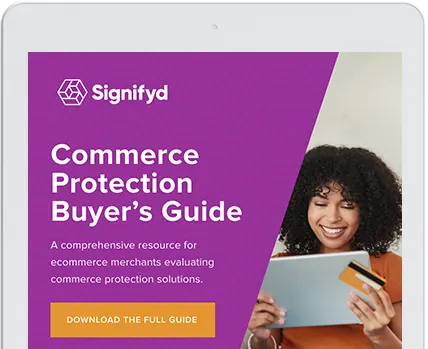What is a chargeback?
In the U.S., a cardholder has the right to request a refund from their issuing bank for any transaction or purchase made with their credit card.
Specifically, under Regulation Z within The Truth in Lending Act, which covers credit cards, and Regulation E in The Electronic Fund Transfer Act, which covers debit cards, cardholders are afforded reversal rights, meaning that they are guaranteed a right to receive their money back on a purchase and reverse the charge.
Usually, the cardholder recovers their money from the merchant directly, in the form of a return or refund. (Note that while a merchant may hold a “no refund” policy, ultimately, if a consumer receives a product that is broken, different than described or generally displeased with the purchase these regulations mandate that a merchant must honor the consumer’s right to a refund.)
In the case that the cardholder is unable to receive a refund from the merchant, or the merchant refuses to do so, a cardholder has the ability to contact the bank that issued them their credit or debit card (called the issuing bank) and file a chargeback request to recover the debt.
Types of chargebacks
The first thing to know about chargebacks is that they’re not all the same. When the cardholder initiates a chargeback abuse, they are prompted to give a reason for doing so. The most common reasons are:
- Billing dispute: Merchants who make billing errors (either by billing too much or double billing their customers) will be at risk of a chargeback. While many merchants proactively correct any billing errors, billing issues unbeknownst to merchants that don’t result in a quick refund will likely result in a chargeback.
- Broken item: When a customer receives an item that they claimed was broken upon arrival or quickly breaks down after, the merchant may receive a broken item chargeback.
- Item not received: Item not received is the chargeback filed against a merchant when a customer reports that they never received the good that they paid for.
- Item significantly not as described: If a merchant ships a red t-shirt when a customer ordered a blue one, the merchant may receive an item significantly different than described chargeback.
- Transaction not recognized: This fraud-related chargeback is reported to merchants from customers who claim to not know why the transaction was reported on their card.
- Fraud, card not present: This more commonly reported fraud-related chargeback is levied against merchants when a consumer claims that their card information was stolen.
Most of these chargebacks are fairly self-explanatory, but they generally fall into three categories:
- Actual fraud: The most obvious reason for a chargeback is also the most common. A fraudster used a legitimate cardholder’s information, purchased an item from a merchant and the merchant shipped said order to the fraudster. The real cardholder, seeing this charge on their statement, files a chargeback request with their issuing bank against the charges on their credit or debit card. In cases of actual fraud, there is little that merchants can do other than refund the sale amount without the expectation of receiving their items back.
- Merchant error or negligence. The merchant either never shipped out the order or shipped out an item that was broken or different than described, and failed to provide good customer service to rectify the situation. When the authorized cardholder fails to receive the item they paid for, they file a chargeback on that transaction, requesting a refund.
- Friendly fraud: Friendly fraud (also called chargeback fraud) is an industry term for authorized cardholders who dispute seemingly legitimate charges to their credit cards. The authorized cardholder may file a chargeback on a legitimate charge for a few reasons: (1) they want to avoid paying for the order in question, (2) they may have forgotten they made the purchase, or (3) there may be another household member who made the purchase in their name, and they don’t recognize the transaction.
Ramifications of chargebacks
Because of the cost and time involved in the chargeback automation dispute process, card associations are extremely strict with merchants around what is acceptable for a chargeback. Most merchants are only able to reach a 1% chargeback rate on any form of payment (Visa, American Express, Mastercard, etc.) before being placed on a chargeback watchlist by that card association.
If a merchant incurs a chargeback rate greater than 1% of orders on a particular card association brand, (e.g. more than 1% of orders processed with Mastercard were chargebacks) that merchant has several detrimental penalties that they can incur.
The first and most painful are higher processing fees on all orders. For example, if a merchant’s normal processing fee for Visa was 3%, Visa could increase that fee to 3.5% or 4% to process all orders, cutting into the merchant’s profit margin.
Secondly, a merchant might lose the ability to fight chargebacks. If a merchant has suffered a high degree of chargebacks on American Express, AmEx might suspend that merchants ability to fight any chargebacks until the merchant brings down their chargeback rate.
Third, a merchant may be placed in a chargeback monitoring program, implemented by the card association to identify merchants with higher than normal chargeback rates. Merchants who land in a chargeback monitoring program may have restrictions placed on their merchant account and further fees levied as the card association attempts to help them reduce their chargeback rate.
Lastly and most seriously, if merchants fail to bring down their chargeback rate after several months, they might lose the ability to transact payments within a certain card association or even more seriously, might have their merchant account shut down by the acquiring bank, afraid of the losses they might incur by continuing to underwrite the merchant.
If you are an online merchant evaluating commerce protection vendors, you might be interested in our free Commerce Protection Buyer’s Guide. This comprehensive guide outlines the evolution of commerce protection from fraud prevention and details the integral components of a commerce protection solution. Takeaway resources include:
- A sample RFI template to leverage in your evaluation process
- Tips on how to build a business case for a commerce protection solution
- How to evaluate ROI and understand the tools used to protect against fraud and chargebacks
- How to find the right solution for your business
We can help you avoid chargebacks












